[English] 日本語
 Yorodumi
Yorodumi- PDB-7p52: GlnK1 from Methanocaldococcus jannaschii with Mg-ATP and 2-oxoglu... -
+ Open data
Open data
- Basic information
Basic information
| Entry | Database: PDB / ID: 7p52 | ||||||
|---|---|---|---|---|---|---|---|
| Title | GlnK1 from Methanocaldococcus jannaschii with Mg-ATP and 2-oxoglutarate at a resolution of 1.2 A | ||||||
 Components Components | Nitrogen regulatory protein GlnK1 | ||||||
 Keywords Keywords | SIGNALING PROTEIN / PII-family / Methanococcales / methanogenic archaea / hyperthermophile / hydrogenotrophic / nitrogen metabolism / protein regulation / inhibitor / conformational change / T-loop / ATP / 2-oxoglutarate | ||||||
| Function / homology |  Function and homology information Function and homology informationregulation of nitrogen utilization / enzyme regulator activity / ATP binding / cytosol Similarity search - Function | ||||||
| Biological species |   Methanocaldococcus jannaschii DSM 2661 (archaea) Methanocaldococcus jannaschii DSM 2661 (archaea) | ||||||
| Method |  X-RAY DIFFRACTION / X-RAY DIFFRACTION /  SYNCHROTRON / SYNCHROTRON /  MOLECULAR REPLACEMENT / Resolution: 1.20002 Å MOLECULAR REPLACEMENT / Resolution: 1.20002 Å | ||||||
 Authors Authors | Mueller, M.-C. / Wagner, T. | ||||||
| Funding support |  Germany, 1items Germany, 1items
| ||||||
 Citation Citation |  Journal: Int J Mol Sci / Year: 2021 Journal: Int J Mol Sci / Year: 2021Title: The Oxoglutarate Binding Site and Regulatory Mechanism Are Conserved in Ammonium Transporter Inhibitors GlnKs from Methanococcales . Authors: Muller, M.C. / Wagner, T. | ||||||
| History |
|
- Structure visualization
Structure visualization
| Structure viewer | Molecule:  Molmil Molmil Jmol/JSmol Jmol/JSmol |
|---|
- Downloads & links
Downloads & links
- Download
Download
| PDBx/mmCIF format |  7p52.cif.gz 7p52.cif.gz | 74.9 KB | Display |  PDBx/mmCIF format PDBx/mmCIF format |
|---|---|---|---|---|
| PDB format |  pdb7p52.ent.gz pdb7p52.ent.gz | 54 KB | Display |  PDB format PDB format |
| PDBx/mmJSON format |  7p52.json.gz 7p52.json.gz | Tree view |  PDBx/mmJSON format PDBx/mmJSON format | |
| Others |  Other downloads Other downloads |
-Validation report
| Summary document |  7p52_validation.pdf.gz 7p52_validation.pdf.gz | 1.5 MB | Display |  wwPDB validaton report wwPDB validaton report |
|---|---|---|---|---|
| Full document |  7p52_full_validation.pdf.gz 7p52_full_validation.pdf.gz | 1.5 MB | Display | |
| Data in XML |  7p52_validation.xml.gz 7p52_validation.xml.gz | 9.1 KB | Display | |
| Data in CIF |  7p52_validation.cif.gz 7p52_validation.cif.gz | 12.7 KB | Display | |
| Arichive directory |  https://data.pdbj.org/pub/pdb/validation_reports/p5/7p52 https://data.pdbj.org/pub/pdb/validation_reports/p5/7p52 ftp://data.pdbj.org/pub/pdb/validation_reports/p5/7p52 ftp://data.pdbj.org/pub/pdb/validation_reports/p5/7p52 | HTTPS FTP |
-Related structure data
| Related structure data |  7p4vC  7p4yC  7p50C 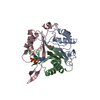 2j9dS S: Starting model for refinement C: citing same article ( |
|---|---|
| Similar structure data |
- Links
Links
- Assembly
Assembly
| Deposited unit | 
| ||||||||||||
|---|---|---|---|---|---|---|---|---|---|---|---|---|---|
| 1 | 
| ||||||||||||
| Unit cell |
| ||||||||||||
| Components on special symmetry positions |
|
- Components
Components
-Protein , 1 types, 1 molecules A
| #1: Protein | Mass: 12538.638 Da / Num. of mol.: 1 Source method: isolated from a genetically manipulated source Details: The formylation on the initial methionine was modelled. Source: (gene. exp.)   Methanocaldococcus jannaschii DSM 2661 (archaea) Methanocaldococcus jannaschii DSM 2661 (archaea)Tissue: / / Cell: / / Cell line: / / Gene: glnK1, MJ0059 / Organ: / / Plasmid: pET-24b (+) / Production host:  |
|---|
-Non-polymers , 6 types, 183 molecules 


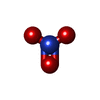







| #2: Chemical | ChemComp-ATP / |
|---|---|
| #3: Chemical | ChemComp-AKG / |
| #4: Chemical | ChemComp-GOL / |
| #5: Chemical | ChemComp-NO3 / |
| #6: Chemical | ChemComp-MG / |
| #7: Water | ChemComp-HOH / |
-Details
| Has ligand of interest | Y |
|---|---|
| Has protein modification | Y |
-Experimental details
-Experiment
| Experiment | Method:  X-RAY DIFFRACTION / Number of used crystals: 1 X-RAY DIFFRACTION / Number of used crystals: 1 |
|---|
- Sample preparation
Sample preparation
| Crystal | Density Matthews: 3 Å3/Da / Density % sol: 58.97 % / Description: Transparent cube |
|---|---|
| Crystal grow | Temperature: 291.15 K / Method: vapor diffusion, sitting drop / pH: 8.5 Details: GlnK1 was crystallized at 11.2 mg/ml in 25 mM Tris/HCl pH 7.6, 10% glycerol, 2mM dithiothreitol and 500mM NaCl on 96-Well MRC 2-Drop Crystallization Plates in polystyrene (SWISSCI). GlnK1 ...Details: GlnK1 was crystallized at 11.2 mg/ml in 25 mM Tris/HCl pH 7.6, 10% glycerol, 2mM dithiothreitol and 500mM NaCl on 96-Well MRC 2-Drop Crystallization Plates in polystyrene (SWISSCI). GlnK1 was cocrystallized with 2 mM ATP, 2 mM 2-oxoglutarate and 2 mM MgCl2. Drop of 0.6 ul of protein sample was mixed with 0.6 ul of the crystallization solution. The reservoir contained 90 ul of the following crystallization solution: 20% PEG 3,350, 100 mM Bis-Tris propane pH 8.5 and 200 mM sodium nitrate. |
-Data collection
| Diffraction | Mean temperature: 100 K / Serial crystal experiment: N |
|---|---|
| Diffraction source | Source:  SYNCHROTRON / Site: SYNCHROTRON / Site:  SLS SLS  / Beamline: X06DA / Wavelength: 0.99187 Å / Beamline: X06DA / Wavelength: 0.99187 Å |
| Detector | Type: DECTRIS PILATUS 2M-F / Detector: PIXEL / Date: Feb 25, 2020 |
| Radiation | Protocol: SINGLE WAVELENGTH / Monochromatic (M) / Laue (L): M / Scattering type: x-ray |
| Radiation wavelength | Wavelength: 0.99187 Å / Relative weight: 1 |
| Reflection | Resolution: 1.2→44.5265 Å / Num. obs: 31673 / % possible obs: 89.8 % / Redundancy: 9.4 % / CC1/2: 0.999 / Rmerge(I) obs: 0.057 / Rpim(I) all: 0.02 / Rrim(I) all: 0.06 / Net I/σ(I): 17.8 |
| Reflection shell | Resolution: 1.2→1.24 Å / Redundancy: 8.3 % / Rmerge(I) obs: 1.209 / Mean I/σ(I) obs: 1.7 / Num. unique obs: 1585 / CC1/2: 0.642 / Rpim(I) all: 0.443 / Rrim(I) all: 1.29 / % possible all: 99.6 |
- Processing
Processing
| Software |
| ||||||||||||||||||||||||||||||||||||||||||||||||||||||||||||||||||||||||||||||||||||
|---|---|---|---|---|---|---|---|---|---|---|---|---|---|---|---|---|---|---|---|---|---|---|---|---|---|---|---|---|---|---|---|---|---|---|---|---|---|---|---|---|---|---|---|---|---|---|---|---|---|---|---|---|---|---|---|---|---|---|---|---|---|---|---|---|---|---|---|---|---|---|---|---|---|---|---|---|---|---|---|---|---|---|---|---|---|
| Refinement | Method to determine structure:  MOLECULAR REPLACEMENT MOLECULAR REPLACEMENTStarting model: 2J9D Resolution: 1.20002→44.5265 Å / SU ML: 0.11 / Cross valid method: THROUGHOUT / σ(F): 1.35 / Phase error: 19.79 / Stereochemistry target values: ML Details: The last refinement steps were carried out with hydrogens in riding mode
| ||||||||||||||||||||||||||||||||||||||||||||||||||||||||||||||||||||||||||||||||||||
| Solvent computation | Shrinkage radii: 0.9 Å / VDW probe radii: 1.11 Å / Solvent model: FLAT BULK SOLVENT MODEL | ||||||||||||||||||||||||||||||||||||||||||||||||||||||||||||||||||||||||||||||||||||
| Displacement parameters | Biso max: 74.74 Å2 / Biso mean: 21.9875 Å2 / Biso min: 9.16 Å2 | ||||||||||||||||||||||||||||||||||||||||||||||||||||||||||||||||||||||||||||||||||||
| Refinement step | Cycle: final / Resolution: 1.20002→44.5265 Å
| ||||||||||||||||||||||||||||||||||||||||||||||||||||||||||||||||||||||||||||||||||||
| LS refinement shell | Refine-ID: X-RAY DIFFRACTION / Rfactor Rfree error: 0 / Total num. of bins used: 11
|
 Movie
Movie Controller
Controller


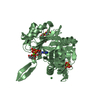

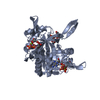
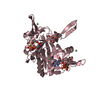

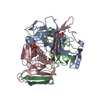
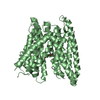

 PDBj
PDBj






